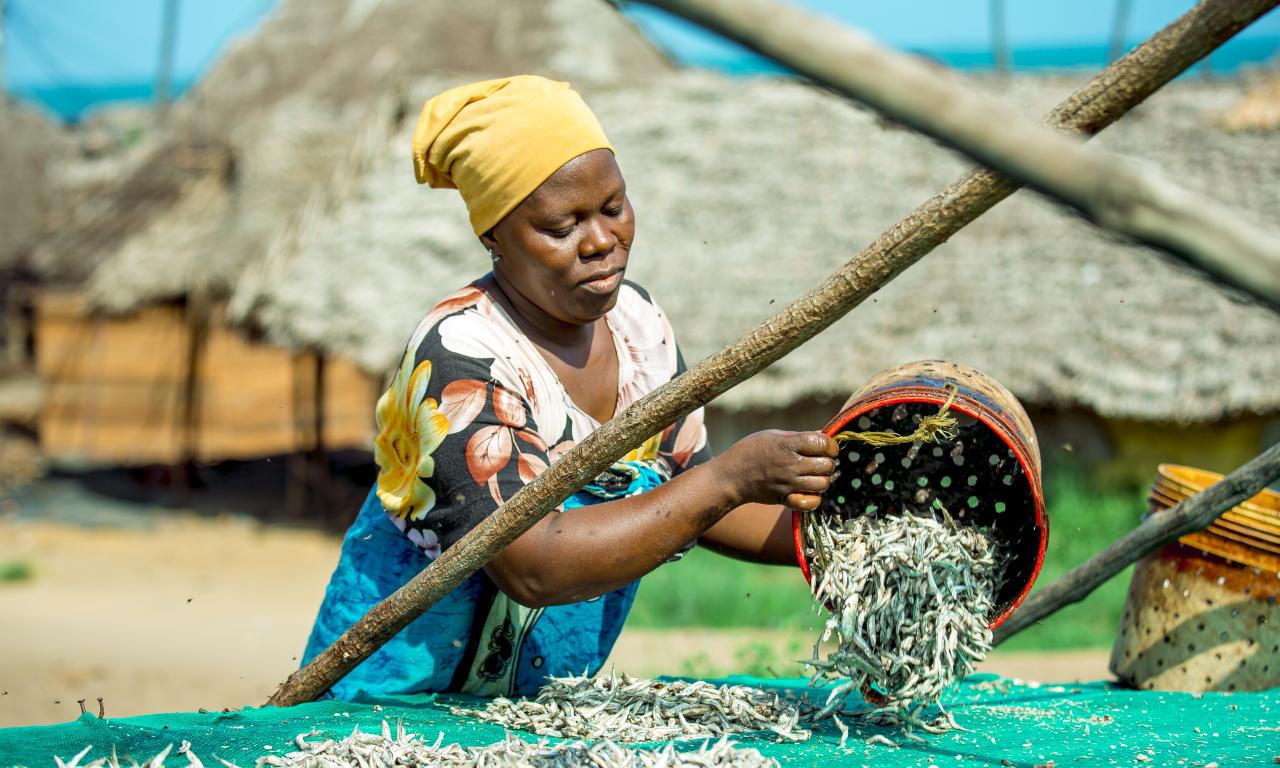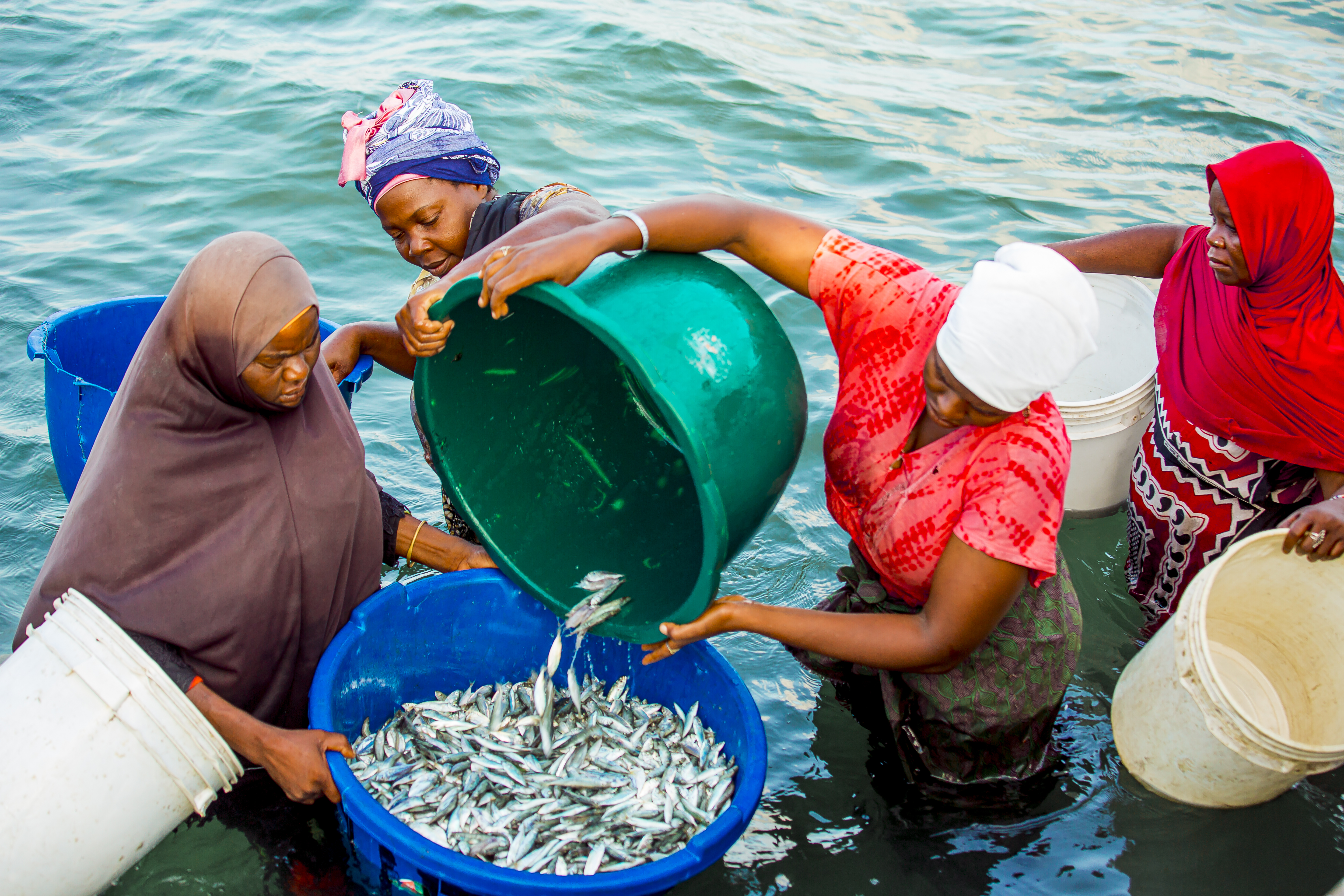
From October to December 2024, WorldFish researchers conducted a comprehensive post-harvest fish loss assessment in the ‘Dagaa’ fish value chain, spanning from Tumbuju in Mafia Island, Tanzania, to Lubumbashi in the Democratic Republic of Congo (DRC). ‘Dagaa’, a small pelagic fish, is an affordable protein source for the people in East and Central Africa, playing a significant role in the region's food, nutrition, and income security.
The study, part of Asia–Africa BlueTech Superhighway (AABS) Work Package (WP) 3 ‘Climate-smart Technologies for Reducing Aquatic Food Loss and Waste’, aimed to explore market opportunities at a local level (Mafia island), national level (Soweto Mbeya), and a regional level Kasumbalesa (Zambia/DRC border) and Lubumbashi, focusing on reducing fish loss and waste.
“The efforts align with Tanzania's ambition to find and implement multidimensional solutions to reduce fish loss and waste in the Dagaa value chain,” said Aditya Parmar, WorldFish Scientist and WP3 Lead. “The first step was to map the entire value chain of marine Dagaa fish from the Tanzanian coast to DRC, as end market demand is crucial for the product’s success,” he added.
Expanding Value Chain Assessment to Include Regional Market Dynamics
For the last three decades, the government of Tanzania has been assessing fish loss with a recent fish loss assessment focusing on ‘Dagaa’ fishery conducted from 2021 to 2024 in partnership with the Food and Agriculture Organization (FAO) and the Norwegian Agency of Development Cooperation (NORAD). This initiative led to the crafting of a Multidimensional Solutions Strategy which addresses factors contributing to fish loss and waste, including policy and regulations, technology, knowledge and skills, markets, social and gender equity, and more. The Tanzanian Ministry of Livestock and Fisheries, in collaboration with WorldFish and other partners, is implementing this multidimensional strategy which emphasizes climate-smart technologies, improved market access, and capacity building among other areas.
However, all current and previous fish loss assessments conducted in the country have primarily focused on domestic markets. They overlook the regional dynamics vital to understanding fish trade, as over 80% of Tanzania's marine Dagaa is exported to regional markets in countries such as Zambia, the DRC, Rwanda, and Burundi. The current assessment by WP 3 is an attempt to expand the scope of the study to include regional market contexts.

Findings from the Load Track Assessment
The assessments took place over a period of 63 days. Data collected included losses related to the physical quantity and quality of Dagaa that result in discounted prices and thus economic loss, market forces such as supply and demand, and opportunity cost due to the reduced number of effective fishing days in avoiding potential losses.
The primary fish loss and waste assessment methods include the Informal Fish Loss Assessment Method (IFLAM), Load Tracking (LT), and the Questionnaire Loss Assessment Method (QLAM). For this study, researchers used the LT food loss and waste assessment method. LT helps measure losses at different stages of the distribution chain, including fishing, transport, processing, and marketing. Data on the causes and effects of losses from an IFLAM study are verified using QLAM before implementing any interventions. By combining IFLAM, LT, and QLAM, researchers can monitor and assess the impact of these interventions.
Key findings from the study included -
- Compliance with good handling practices (GHP) is minimal, leading to contamination and poor-quality products.
- Dagaa products experience quality degradation due to prolonged exposure to high ambient temperatures, increasing spoilage and fish loss.
- Delays within the value chain including during fishing, bargaining, processing, distribution, and marketing, intensify losses of perishable Dagaa.
- Good manufacturing practices (GMP) are not adhered to, particularly in boiling and drying processes, contributing to quality decline.
- Inefficient boiling and drying technologies result in poor-quality products that fetch low market prices.
- Sun drying is the most popular Dagaa processing method, but its effectiveness is reduced during the rainy season, leading to increased loss and waste.
- An unfavorable business environment and lack of business skills among stakeholders create further delays in the distribution of perishable Dagaa. For example, a lack of standardization in units of weight measurement when selling or buying Dagaa leads to financial losses.
Listen to Yahya I. Mgawe, Fisheries and Coastal Resources Management Consultant, United Republic of Tanzania, sharing insights about the importance of small-scale fisheries in Tanzania, the challenges of post-harvest losses, and the innovative, multi-dimensional strategies being implemented to improve fish quality, reduce losses, and support the livelihoods of local fishing communities.
Tracking the Dagaa Value Chain to Identify Weak Links
The Dagaa supply chain operates through two primary marketing channels - domestic and export – which face significant physical and quality losses. The critical actors of the value chain comprise fishers, processors, transporters, retailers, wholesalers, and consumers.
Here are the various challenges in the Dagaa value chain – from capture to consumption - which result in significant fish losses for fishers and contribute to the perception of Dagaa as a low-value product in the market.
- Challenges in the fishing node involve delays, small-sized catches, and inadequate storage conditions, resulting in about 10% of Dagaa stowed in fish holds being unfit for human consumption.
- Inadequate infrastructure and facilities for fish landing during unloading add to the fisher’s woes.
- Next comes the preliminary processing (salt water boiling stage) which is limited by a shortage of boiling pans and operators, leading to spoilage if Dagaa is kept unprocessed for over four hours. Moreover, using firewood as an energy source causes forest depletion and, in some cases, even mangroves.
- In the post-boiling processing (sun-drying stage), value chain actors dry boiled Dagaa either on tarpaulin which is placed on bare sandy ground, or elevated drying racks. While drying on tarpaulin is cheaper, it increases the risk of contamination. The study indicates that the presence of sand significantly influences wholesale pricing in Lubumbashi, with sandy products often priced at half the standard rate - for example from US$ 700 to US$ 350 per 201kg sack.
- The storage node utilizes small thatched huts for storing dried Dagaa and an assortment of equipment such as engines and fuel, which results in cross-contamination. The huts are poorly constructed, lacking sufficient ventilation and protection from rodents. It is common to find Dagaa produced from different fishing cycles mixed together, which diminishes the market value due to varying quality.
- At the distribution node, poor and high costs of transportation act as a deterrent. Vertical linkages exist between agents and owners at different stages of the channels to end markets. However, inadequate working capital slows down the efficient movement of goods, resulting in approximately 30 days for items to reach the DRC. Additionally, high rates of fragmentation are reported due to overloading and stacking.
- In the marketing node, marketing malpractices, mixing good quality with poor, improper sieving, flimsy packaging bags, and breakages – even in sand-free Dagaa - cause losses to the fishers. Weak horizontal linkages between actors, particularly at the production stage, fail to reduce transaction costs or enhance bargaining power.
- In the consumption stage, inadequate post-harvest handling and storage have historically affected Dagaa’s market perception, often associating it with lower-income households. Significant amounts of Dagaa continue to be discarded at retail and household levels due to spoilage, contamination, and limited storage options, exacerbating fish waste. The key challenge now is to enhance Dagaa’s value and market appeal through improved drying techniques, better storage, branding, and strategic market expansion.
Next Steps – Establish Good Practices, Coach Value Chain Actors
For AABS, Mafia Island is a focal site for promoting sustainable post-harvest processing practices to reduce loss and waste in Dagaa fisheries. Researchers are working with the central government, local government authorities, local cooperatives, and fishers to support innovative and traditional methods that respect the marine ecosystem while enhancing livelihoods.
“The load tracking study will not only help create a better business environment but also highlight the vital role of marine Dagaa in supporting food security, restoring coastal ecosystems, and uplifting communities,” said Aditya. “The intention is to establish hubs that will showcase GHP and GMP, as well as provide business coaching to small-scale value chain actors,” he added.
